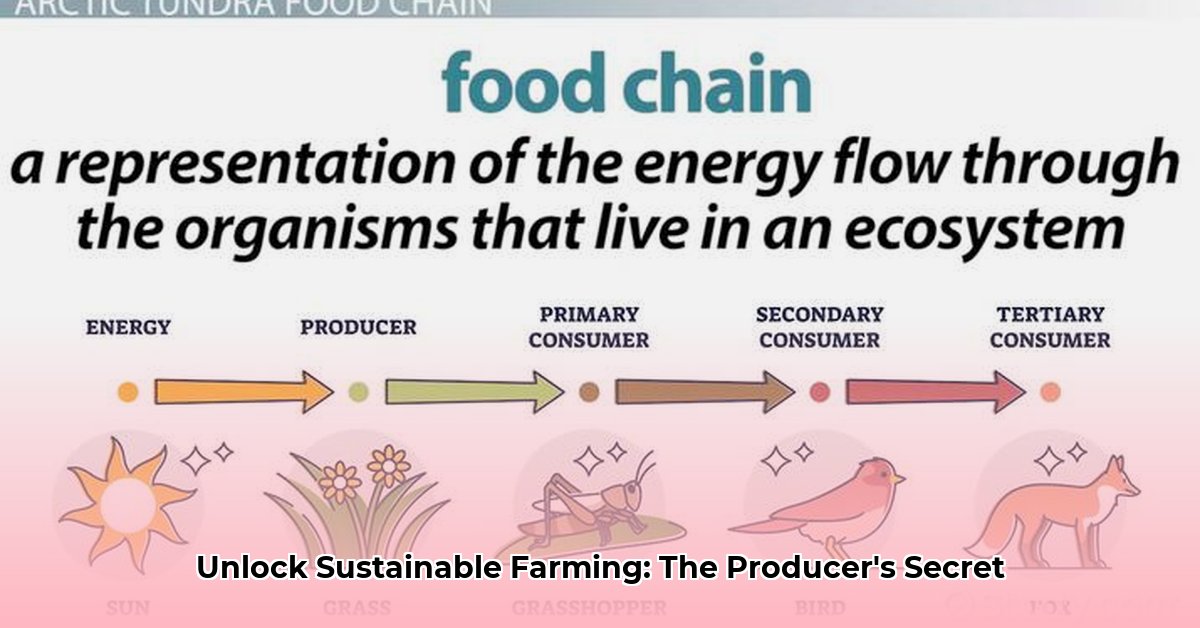Farming today extends beyond mere food production; it’s about fostering vibrant communities and safeguarding our environment. This article delves into how sustainable agriculture farmers achieve precisely that. For more on North American farmers, check out this resource. We’ll examine the advantages and disadvantages of various farming models, such as community-supported agriculture (CSAs), and provide actionable advice for establishing a prosperous and sustainable farm enterprise. Discover how these farmers are making a tangible difference, one harvest at a time.
The Producer Role in Community: Cultivating More Than Just Crops
Today, being a food producer involves much more than simply growing crops; it’s about building solid communities, strengthening economies, and safeguarding our earth. Sustainable farming, community involvement, and profitability form the three pillars of stability. A deficiency in one area can compromise the entire structure. Community engagement is crucial for long-term viability of any local farming business. Producers must not only cultivate the land but also nurture relationships within their community, creating a network of support and shared purpose.
Beyond the Fields: Nurturing Community Connections
Successful farmers cultivate relationships as diligently as they cultivate crops. Building robust community connections is as crucial as nurturing healthy plants. Here’s how you can effectively engage your community and boost your farm’s profile:
- Personalize Interactions: Farmers’ markets offer invaluable face-to-face interactions. Hosting farm dinners or open houses allows people to experience your operation firsthand, fostering trust and demonstrating your dedication. These direct encounters instill a profound sense of belonging within the local food system. Consider establishing a farm store where community members can purchase fresh produce directly, strengthening the bond between producer and consumer.
- Cultivate Community Supported Agriculture (CSA): CSAs represent an excellent avenue for engaging directly with your clientele. They foster devotion and cultivate awareness about the origins of their sustenance. Clearly articulate the benefits of joining your CSA (e.g., access to seasonal produce, supporting local agriculture). However, maintain practicality; income patterns may exhibit seasonal variations, necessitating meticulous preparation. Diversifying income streams is critical for managing seasonal variability, with 92% of farms with diversified income reporting greater financial stability.
- Embrace Collaboration: Partner with nearby enterprises—eateries, breweries, and retail establishments—to broaden your scope and fortify the local economy. View this as an advantageous alliance. Such collaborations expand your reach, foster trust, and build community pride. Consider offering joint promotions or creating products that showcase the ingredients from your farm.
- Share Your Expertise: Offer educational workshops, classes, or demonstrations to educate individuals about farming and local food. Empowering your community through knowledge equips them to make well-informed decisions. This cultivates a communal sense of ownership and responsibility for the local nourishment ecosystem. Invite local schools or organizations for field trips to your farm, providing hands-on learning experiences.
Overcoming Sustainable Farming Challenges: Striking a Delicate Balance
Adopting a community-centric approach to farming presents difficulties. Balancing sustainability with profitability necessitates thorough planning and adaptability. Below are common challenges and viable strategies:
| Challenge | Potential Solutions |
|---|---|
| Changing consumer demands | Offer a diverse range of products, including unique or heirloom varieties. Explore adding value to your produce (e.g., jams, pickles, sauces, baked goods). Build brand loyalty through consistent quality, transparent practices, and engaging storytelling. Conduct regular surveys or focus groups to understand evolving consumer preferences. |
| Access to land and resources | Advocate for policies that support local farmers and promote land access initiatives. Explore innovative farming methods to boost efficiency and reduce resource needs (e.g., vertical farming, hydroponics). Consider collaborating with other producers to share resources, equipment, and knowledge. Seek grants or funding opportunities specifically for sustainable agriculture projects. |
| Getting your product to market | Utilize online sales channels (website, e-commerce platform, farmers’ market aggregators). Team up with local distributors, retailers, or restaurants to expand your reach. Participate in local food hubs or cooperatives to streamline distribution and marketing efforts. Consider a mobile farmers’ market to reach underserved communities. |
| Income variation (CSAs) | Diversify your income streams (e.g., farmers’ markets, direct sales, value-added products, on-farm events). Cultivate strong relationships with your CSA members; open communication is crucial, provide flexible payment options and customizable share options. Offer work-trade opportunities for members to reduce costs and build community. |
Cultivating a Sustainable Tomorrow: Embracing Foresight
Sustainable agriculture extends beyond present-day harvests; it entails fortifying resilience for subsequent epochs. This necessitates a forward-thinking perspective and unwavering dedication to ecological stewardship. Are you thinking long-term regarding your land? Protect our vital resources for future generations.
- Adopt a Long-Term Mentality: Prioritizing soil health, conserving water resources, and promoting biodiversity is essential for prolonged farm prosperity and communal well-being, establishing a resilient base for forthcoming yields. Soil health practices involve no-till farming, cover cropping, and composting. Farms employing soil conservation practices see a 15-25% increase in long-term productivity.
- Champion Advocacy: Advocate for regulations that safeguard local farmers and endorse sustainable farming methods, encompassing support for equitable pricing, environmental mandates, and farmland preservation. Join agricultural organizations to amplify your voice and influence policy decisions.
- Embrace Modernization: Explore cutting-edge technologies and agricultural methodologies, consistently evaluating their ecological footprint. Remain receptive to adopting eco-friendly innovations, while consistently prioritizing environmental preservation. Examples include precision irrigation, renewable energy systems, and biological pest control.
Gauging Achievements Beyond Financial Gains
The triumph of a community-driven farm transcends simple monetary metrics; contemplate a wider viewpoint:
- Evaluate Community Footprint: Have you played a role in driving the local economy? Have you established enduring connections with your community’s inhabitants? Track the number of local jobs created or supported by your farm.
- Assess Environmental Accountability: What actions have you taken to minimize the ecological effect of your farm? Measure your carbon footprint, water usage, and soil health improvements.
- Assess Fairness and Equity: Do your ethical standards in farming extend to your workforce and surrounding community? Ensure fair wages, safe working conditions, and opportunities for advancement for your employees.
Ultimately, legitimate prosperity emanates from a thriving community, a robust environment, and a durable food ecosystem, wherein the producer assumes a crucial, versatile function. The odyssey persists, presenting ongoing prospects for enrichment.
How to Increase CSA Farm Profitability Through Diversified Marketing Strategies
Key Takeaways:
- Smart crop selection, effective marketing, and efficient farm management are vital for CSA success.
- High sales don’t guarantee high profits; careful cost analysis per crop is crucial.
- Reaching a wider customer base, building community, and boosting income requires diverse marketing strategies.
- Farmers must understand their operating expenses, gross profit margins, and adapt to current trends.
- Supporting local and sustainable agriculture benefits consumers and creates a healthier food system.
Understanding the CSA Landscape
Let’s face it; operating a flourishing Community Supported Agriculture (CSA) venture involves more than sowing seeds and anticipating harvests. It represents a business, necessitating a sound marketing strategy to thrive. What marketing methodologies can ensure powerful results? The solution resides in adopting diversified marketing strategies.
Diversifying Your Marketing Approach
What marketing channels are you employing presently? A uniform strategy seldom delivers optimal outcomes. Refrain from solely depending on informal referrals; explore multiple means to engage your targeted clientele. How are you differentiating your brand? Highlight what makes your farm unique (e.g., organic practices, heirloom varieties, community involvement).
- Harness Digital Marketing: Utilize websites, social networks (Instagram, Facebook), and email bulletins to accentuate your farm’s singular narrative and offerings. Regularly update your website with fresh content, recipes, and farm news. Superior images and videos serve as potent allies. Farms using social media see a 20% increase in direct sales. Consider using targeted advertising to reach specific demographics or interests.
- Prioritize Community Engagement: Develop alliances with nearby enterprises, partake in farmers’ markets, and arrange farm gatherings. Establish rapport; this encompasses more than just sales, fostering trust and collective pride. Volunteer at local events or sponsor community initiatives to increase visibility and goodwill.
- Leverage Traditional Marketing: Flyers, advertisements in local newspapers, and alliances with nearby eateries can demonstrate efficacy, particularly in reaching older demographics. Design eye-catching flyers and brochures that highlight the benefits of your CSA program.
Analyzing Your Costs and Profits
Comprehending your financial framework remains paramount. Are you scrupulously documenting expenditures? Ascertaining expenses for each crop facilitates equitable share pricing and profit maximization. Track all inputs, labor costs, and overhead expenses. Resources such as spreadsheets or accounting software can greatly assist. Calculating your Gross Profit Margin and Return on Investment (ROI) will assist in streamlining output and pricing. Regularly review your financial statements to identify areas for improvement.
Strategies for Success
Here’s a roadmap to guide you:
- Conduct a Crop Enterprise Analysis: Ascertain which crops generate substantial returns and garner substantial consumer interest.
- Implement Efficient Resource Management: Streamline operations, optimize consumption of water and fertilizer, and investigate precision agricultural innovations to curtail waste and augment yields. Consider investing in efficient irrigation systems, soil testing, and composting programs.
- Explore Value-Added Products: Consider offering jams, pickles, sauces, baked goods, or other value-added products to










